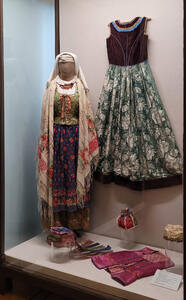Silk in the Traditional Culture of the Peoples of Eastern and Southeastern Europe

In the 18th century, silk clothing was an important marker demonstrating the status of the highest Polish aristocracy. Later, in the first half of the 19th century, low duties on the imported silk and the proximity of European markets contributed to its propagation. In the early 20th century, the domestic silk production was kick-started. So, in the Warsaw Governorate, there were yarn production, silk bleaching, dyeing, and ribbon-making productions. The Piotrków Governorate produced silk and semi-silk fabrics, including plush.
Silk was one of the important components of trade, in which the Jewish community played a significant role. In turn, the Jewish costume was characterized by an abundance of expensive silk fabrics.
The men’s costume included a silk cap, which also was a religious item; it had to cover the head of a devout Jew. In addition, to emphasize wealth and luxury, silk filled the inner space of a synagogue, around which the spiritual life of the community revolved. It was used for the parochet curtains that covered the Torah ark. Parochets were often a gift from members of the community; this demonstrated not only a special attitude towards religious paraphernalia, but also the community’s wealth.
Several local traditional costume sets were common across the region, each was characterized by the use of silk materials. Sleeveless jackets, skirts, aprons were made of purchased fabrics like thick velvet, silk, or satin, which were parts of festive attire in the village environment. Ribbons, flowers, or silk thread embroidery were used as decorations for hats. In some governorates, for example, Grodno Governorate, there were silk ribbon factories, while in Minsk, there was a silk-spinning factory, and Mogilev produced new silk fabrics.
Women’s attire. Kielce Governorate. Late 19th – early 20th century, Poles
Women’s dress. Volyn Governorate. Mid-19th century. Ukrainians
Headwear. Mogilev. Late 19th – early 20th century. Jews
Bride’s headwear. Kielce Governorate. 2nd third of the 19th century. Poles
Women’s sleeveless jacket. Minsk Governorate. Late 19th – early 20th century. Belarusians
Child’s hat. Warsaw Governorate. Early 20th century. Poles



